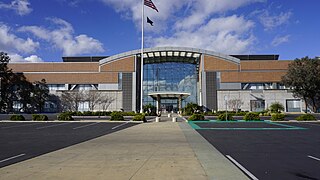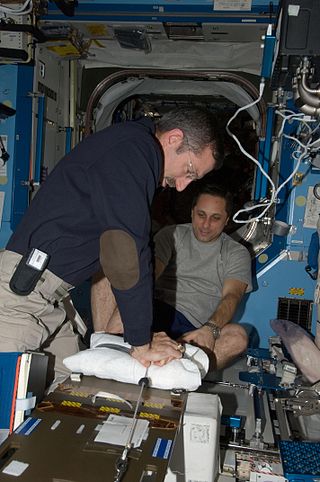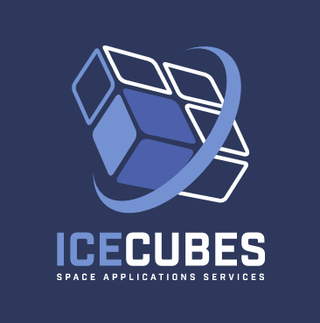Related Research Articles
The following outline is provided as an overview of and topical guide to health sciences:

Neurology is the branch of medicine dealing with the diagnosis and treatment of all categories of conditions and disease involving the nervous system, which comprises the brain, the spinal cord and the peripheral nerves. Neurological practice relies heavily on the field of neuroscience, the scientific study of the nervous system.

Medical ultrasound includes diagnostic techniques using ultrasound, as well as therapeutic applications of ultrasound. In diagnosis, it is used to create an image of internal body structures such as tendons, muscles, joints, blood vessels, and internal organs, to measure some characteristics or to generate an informative audible sound. The usage of ultrasound to produce visual images for medicine is called medical ultrasonography or simply sonography, or echography. The practice of examining pregnant women using ultrasound is called obstetric ultrasonography, and was an early development of clinical ultrasonography. The machine used is called an ultrasound machine, a sonograph or an echograph. The visual image formed using this technique is called an ultrasonogram, a sonogram or an echogram.
Medical physics deals with the application of the concepts and methods of physics to the prevention, diagnosis and treatment of human diseases with a specific goal of improving human health and well-being. Since 2008, medical physics has been included as a health profession according to International Standard Classification of Occupation of the International Labour Organization.

Ambulatory care or outpatient care is medical care provided on an outpatient basis, including diagnosis, observation, consultation, treatment, intervention, and rehabilitation services. This care can include advanced medical technology and procedures even when provided outside of hospitals.

Oleg Yur'yevich At'kov is a Russian cardiologist and former Soviet cosmonaut. With a doctorate from the Russian Academy of Medical Science, Atkov was chosen to be the health specialist on board Soyuz T-10 and Soyuz T-11. After Atkov's rather long time in space, he returned to work at the Myasnikov Institute of Clinical Cardiology to continue his research on the adaptation of weightlessness and cardiology. With his published research and time in space, Atkov holds two of the USSR's highest honors; the Order of Lenin and the title of Hero of the Soviet Union. Atkov is a professor of medicine at the Russian National Research Medical University and currently serves as the vice president of Russian Railways.

Space medicine is a specialized field, which developed from Aerospace medicine, that focuses on the acute medical care of astronauts and spaceflight participants. The spaceflight environment poses many unique stressors to the human body, including G forces, microgravity, unusual atmospheres such as low pressure or high carbon dioxide, and space radiation. Space medicine applies emergency medicine, acute care medicine, critical care medicine, interventional radiology, radiology, austere medicine, and toxicology perspectives treat and prepare for medical problems in space. This expertise is then used to inform vehicle systems design to minimize the risk to human health and performance while meeting mission objectives.
Wyle Laboratories (Wyle) was an American privately held provider of engineering, scientific and technical services to the Department of Defense, NASA, and a variety of commercial customers primarily in the aerospace industry. The company offered services in the areas of test and evaluation; systems engineering and information technology; life cycle and acquisition program management; life sciences research; space medical operations and engineering; and qualification testing for systems and components.
Remote guidance, in the medical context, refers to the supervision or guidance of a medical task, usually a procedure or test, from a remote location. This falls in the realm of real time telemedicine applications. By way of example, a radiologist may guide an ultrasound examination from a remote location. As such, the proximate requisite expertise to accomplish a medical task is significantly diminished. In the previous example, a diagnostic quality ultrasound can be accomplished by non-medically trained individuals manipulating an ultrasound device located with the patient under guidance from a remote location. This is an example of teleradiology If appropriately configured, the remote guidance can originate from another room or floor in the same building, too as far away as another continent or even planet. NASA researchers have successfully demonstrated remote guidance of diagnostic level cardiac ultrasonography using ultrasound on the space station, non-medical astronauts performing the exam as guided by a terrestrially located expert.
Andrew Nicolaides is a British-Greek Cypriot surgeon, and an expert in cardiovascular disease and stroke prevention.
Teledermatology is a subspecialty in the medical field of dermatology and probably one of the most common applications of telemedicine and e-health. In teledermatology, telecommunication technologies are used to exchange medical information over a distance using audio, visual, and data communication. Applications comprise health care management such as diagnoses, consultation, and treatment as well as (continuous) education.
Marnix van Holsbeeck is the director of musculoskeletal radiology in the Department of Radiology and director of radiology in the Department of Orthopaedic Surgery at the Henry Ford Health System. He is an authority in the field of musculoskeletal radiology.

The Microgravity Centre, colloquially known as the "MicroG", at PUCRS university, Porto Alegre, Brazil, was initially created as a laboratory in 1999 by Professor Thais Russomano MD MSc PhD, as the first academic and research establishment dedicated to Space Life Sciences in Latin America. It evolved into a fully multidisciplinary centre in 2006, expanding its areas of research beyond aerospace medicine and engineering, to include pharmaceuticals, biomechanics and physiotherapy, among others.

The International Space Station is a platform for scientific research that requires one or more of the unusual conditions present in low Earth orbit. The primary fields of research include human research, space medicine, life sciences, physical sciences, astronomy and meteorology. The 2005 NASA Authorization Act designated the American segment of the International Space Station as a national laboratory with the goal of increasing the use of the ISS by other federal agencies and the private sector.

Human Research Facility 1 (HRF-1) on board the International Space Station (ISS) allows investigators to study the effects of long-duration space flight on the human body. Equipment in the HRF-1 includes a clinical ultrasound and a device for measuring mass.

The Plasmakristall-3 Plus laboratory was a joint Russian-German laboratory for the investigation of dusty/complex plasmas on board the International Space Station (ISS), with the principal investigators at the German Max Planck Institute for Extraterrestrial Physics and the Russian Institute for High Energy Densities. It was the successor to the PKE Nefedov experiment with improvements in hardware, diagnostics and software. The laboratory was launched in December 2005 and was operated for the first time in January 2006. It was used in 21 missions until it was deorbited in 2013. It is succeeded by the PK-4 Laboratory.
The following page is a list of scientific research that is currently underway or has been previously studied on the International Space Station by the European Space Agency.

Since its establishment in 1958, NASA has conducted research on a range of topics. Because of its unique structure, work happens at various field centers and different research areas are concentrated in those centers. Depending on the technology, hardware and expertise needed, research may be conducted across a range of centers.
Shannan Moynihan is the Deputy Chief of Space and Occupational Medicine at the Johnson Space Center. She has acted as crew surgeon for International Space Station missions.

The International Commercial Experiment Cubesservice is a commercial service that offers access to space for research, technology and education.